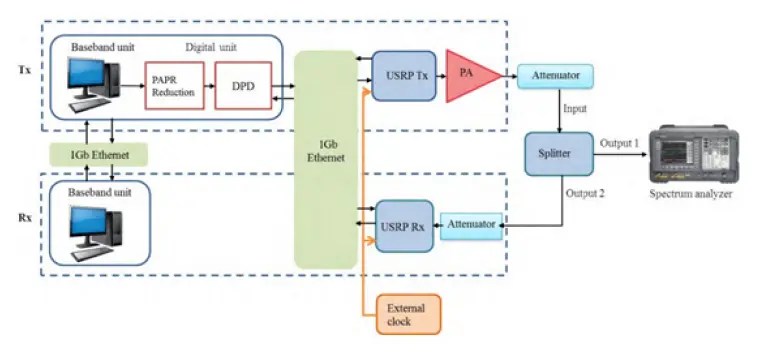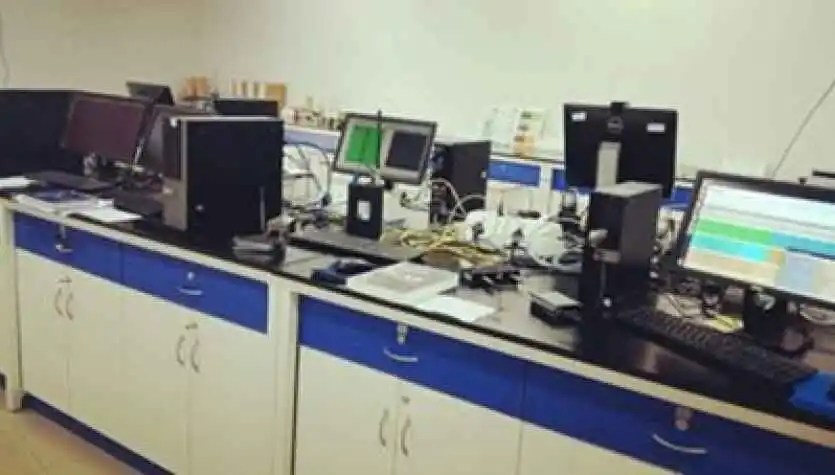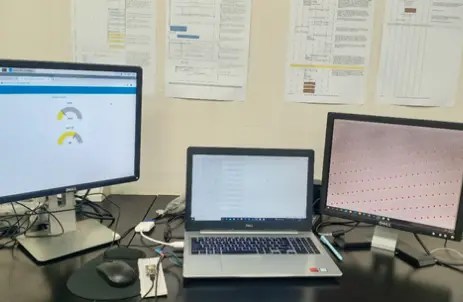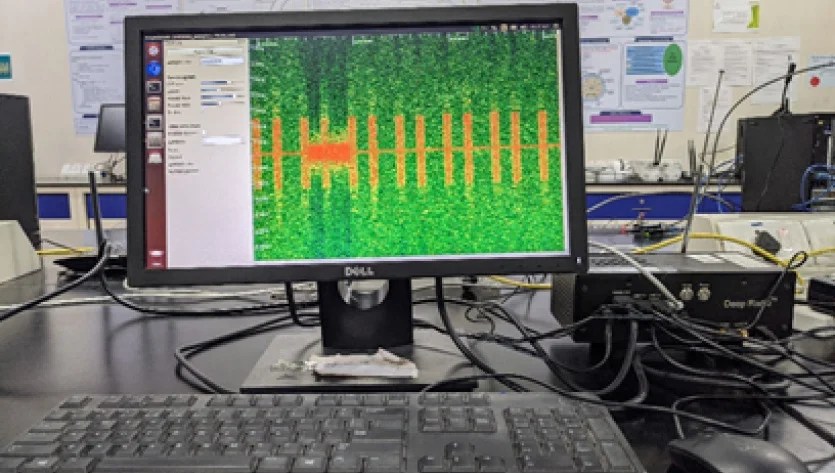Research Centers Of Excellence & Labs
Research Labs at MU
Wireless Innovation and 5G is a research laboratory at Mahindra University focusing on key aspects and challenges in future mobile networks and emerging wireless technologies. The objective of the lab is to develop the advanced solutions for challenging problems of 5G and beyond telecommunication systems.
Research Focus Areas
Active research is being conducted on the areas related to –
Research Facilities
Facilities for PHY layer algorithms
5G/6G PHY Testbed : This state-of-the-art testbed is meant to implement innovative algorithms related to PHY layer of 5G and 6G Communications with main focus on post-OFDM waveforms, RF impairment mitigation, NOMA and massive MIMO. It is equipped with two NI USRPs (X310), Power amplifier, NI Octoclock and other RF components.
It comprises of a complete transceiver chain equipped with two SDRs where we can emulate all PHY algorithms related to signal generation, transmission and reception. The Tx Chain comprises of a baseband unit, a digital unit to mitigate the RF impairments (e.g., HPA non-linearities) and finally RF front-end unit comprising of SDR and HPA. The Rx Chain comprises of RF front-end and a baseband unit. An external clock of 10MHz is connected to both SDRs to achieve coherent reception.

Fig 1 : Architecture of 5G/6G PHY testbed

Fig 2 : Laboratory set up of 5G/6G PHY layer testbed
It can work in two modes : Wireless Transmission mode (Mode A) and Lookback mode (Mode B). In the former, i.e., Mode A, both the Tx and Rx frontends are connected with antennas; either in SISO or MIMO. We can connect two antennas per daughterboard in the SDR. As of now, one daughterboard slot is being used and the other one is reserved for future use. Mode A is mode suited to study the aspects of signal propagation and its reception. BER (bit error rate) is the most important metric to evaluate the quality of reception in Mode A.
In the latter, i.e., Mode B, we can directly loopback the transmitted signal to the Rx via SMA cables. To study the spectrum of the transmitted signal in that mode, we have to put a power splitter, which divides the signal path into two; one for Rx and the other for Spectrum Analyzer. Mode B can be more suited to study the aspects of transmitted signal and analyze its RF impairments. In Mode B, in order to study the quality of the transmitted signal, the ideal metric is MER (modulation error ratio); defined by ETSI for broadcasting industry. The overall architecture of the 6G PHY testbed is shown in figure 1. The laboratory set up of PHY testbed is given in below figure 2.
5G IoT Security Testbed : This testbed in currently under development. It is equipped with two NI USRPs (model 2901) and other RF components.
Facilities for MAC layer issues:
For the MAC layer issues, the proposed algorithms can be tested on System level Wireless communication testbed and involve ML/DL methods
Facilities for System level Wireless communication testbed
5-Nines Radio : 5-Nines Radio is a highly scalable 4G/5G Testbed for emulating 4G/5G networks in real-time in our lab. The testbed emulates both 4G and 5G. Currently, real-time operation of complete 4G systems has been tested. The complete 5G -IoT set up with Non-Stand-Alone (NSA) mode is under test now. The operating band of 4G testbed is LTE band 7 with TX passband 2620 – 2690 MHz and RX passband 2500 – 2570 MHz. With the testbed, we will be able to :
- Use 4G smart phone to access internet via the Testbed (with your programmed SIM cards/excluding programmed SIM cards)
- Connect IoT products via a 5NR-IoT interface
- Understand end-to-end 5G network architecture along with internal functioning of all layers and protocols of core network, access network and user equipment
- Customize the Testbed’s software modules to test your algorithms/ideas
All software modules of the setup such as Core Network, Access Network and UE are active and simulation of 5G network can be performed. As of now, 5G access network module is under test in real-time. The testbed can run with 5 MHz, 10 MHz and 20 MHz configurations. However, it can be extended to support 100 MHz bandwidth. It has been tested with simultaneous maximum connections of eight UEs (combination of smart phones and IoT devices) along with the testbed. In reality, it is expected to connect with several tens of smartphones and IoT devices. You can keep on increasing any number of eNBs/gNBs and UEs. With the transmit power of 10 dBm, the coverage distance is around 30m.
Scope : Platform for UG/PG/PhD thesis projects
- Innovation in 5G wireless technologies such as M2M communications and IoT
- Algorithm development for interference management in 4G and 5G cellular systems
Components of 5-Nines Radio:
- 4G/5G Core network emulator
- 4G/5G eNB emulator
- 4G/5G UE emulator

Fig 3 : Complete Setup with 5-Nines Radio implementation

Fig 4 : 5-Nines Radio NSA configuration

Fig 5 : Integration of IoT network with 5Nines -Radio

Fig 6 : 5NR-IoT Bridge

Fig 7 : IoT Security Testkit
5NR-IoT Bridge : 5NR-IoT Bridge is an interface unit to connect IoT network with 5-Nines Radio. The IoT network consists of a coordinator, several routers and end nodes. All the nodes in the IoT network are connected to various types of low-cost and low-power sensors such as temperature, humidity, air quality, vibration, light level, etc. to read various measurement data and send them to the coordinator via the routers. The 5-Nnies Radio consists of a 4G/5G core network, an Access network(eNB/gNB) and UEs.
IoT Security Testkit : this testkit describes the efficient ways to connect various kind of sensors on the IoT platform along with the visualizations of data using MQTT protocol. IoT is based upon essential components like sensing and embedding components, connectivity, IoT cloud, IoT analytics and data management, end user devices and user interface. In our project by considering all above parameters we have created a setup. The most important and dangerous issue we are facing related to IoT devices in today’s world is Security. So, by capturing and reading packets which are being transferred we got to know various insights related to packets. For efficient analysis, we used parameters like frequency and packet length. Then, to observe the changes that might happen due to DoS attack we have attacked our own server, followed by analyzing the data using python libraries like pandas, NumPy and Matplotlib. Our future work will be on Deep Learning Algorithm to prevent different kind of attacks. Fig. 6 depicts the IoT security testkit.
Facilities for machine learning/deep learning algorithms
Deep Radio : For developing deep learning based wireless applications, this hardware component is used. Utilizing the unused spectrum in the form of Cognitive Radio (CR) is now a necessity for mobile operators to meet the ever-increasing traffic demands. In CR systems, radio frequency samples in a wide range of frequency bands need to be periodically captured and processed to identify how to use the frequency bands efficiently. Using Deep radio, one can do the experimental analysis and verification in real time such as spectrum activity and percentage of occupied bandwidth etc.
Wi-Guy is used in 5Nines radio testbed. It is a portable software defined radio-based platform capable of scanning a range of electromagnetic spectrum for creating radio coverage map and decoding various type of signals transmitted by present day communication systems such as FM radio, GSM, LTE, GPS in real-time.

Figure 8: Deep Radio

Figure 9: Wi-Guy
By using the in-built SDR, the Wi-Guy units read the RF samples in real-time from various frequency bands and process the samples to decode signals and to extract system information. Python programming language is used to acquire and process the real-time signals are transmitted by commercial FM stations, GSM, LTE base stations, and GPS satellites. The Wi-Guy stores the extracted information in the required file formats. The files generated by the Wi-Guy units can be accessed from a PC/Laptop/Tablet/Smartphone
Projects
- Projects have been submitted for external funding – under review now
- Collaboration research project on IoT security between CCoE and MU in the month of January 2020 – complete
In-charges
Dr. Subbarao Boddu, M. Tech., PhD (IIT Kharagpur)
Senior Member IEEE, Fellow of IE (I), Fellow of IETE and Life Member of ISTE









